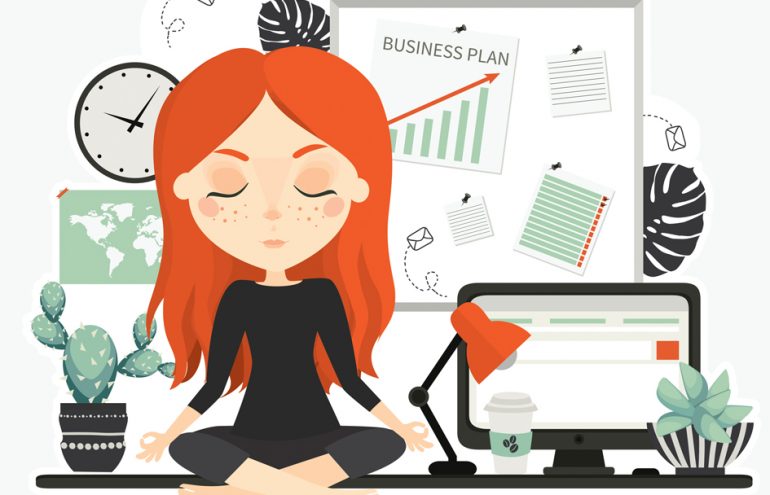For this week’s five, we turned to workplace strategy expert and researcher Leigh Stringer, author of the new book, “The Healthy Workplace: How to Improve the Well-Being of Your Employees—and Boost Your Company’s Bottom Line.”
Steps to Improve Your Health and Beat Back Stress at Work
Over the years, says Stringer, we’ve all developed work styles that are not always good for our physical, mental or emotional health. “It’s not that we’re bad people, or that we aren’t working hard. The problem is we are so focused on work, that we’ve changed the way we eat, move and sleep in a way that is actually counter-productive.”
Here are five ways to be healthier at work, add a little more zen, and get more done while you’re at it.
1. Build Flexibility Into How, When and Where You Work
Studies show people who feel more “in control” of their work and work environment are less likely to suffer from stress and illness and to see increases in productivity. Stringer suggests these options:
- Change where you work. Many people work more effectively at home, in a satellite office, co-working facility, a park or a coffee shop. Obviously this requires good technology and the right protocols (so everyone knows how to reach you), but it can be incredibly empowering.
- Adopt a more flexible work schedule. Vary your arrival and departure times, or try a compressed work week.
- Move more. Are you sitting in one position all day? Change your position often and move around frequently — stand at a table in the break room, walk during conference calls.
- Adjust your work environment. Even if you don’t have a desk that moves up and down, making small adjustments, like moving or adding a computer monitor, turning on a task light or re-orienting furniture can make a major difference in your posture and your productivity.
2. Nurture “Biophilia”
Humans have a strong desire to be in and among nature, says Stringer. This preference, often referred to as biophilia, was introduced by E.O. Wilson, who suggests there is an instinctive bond between human beings and other living systems. Nurturing that bond at work can decrease stress:
- Add natural elements. Small plants or a water feature on your desk, or nearby, are soothing and reduce stress.
- Move your desk next to a window. More natural light will decrease eye strain and improve well-being. Sitting close to a window can even help reset your circadian rhythm and sleep cycle. No windows? Install a circadian lighting system designed to trigger wakefulness. Or, try screwing a “daylight” LED bulb into your office task light. You will be shocked by how much better you feel, says Stringer, and you will likely sleep better at night!
- Add features that mimic nature. Pictures of trees and water, furniture with organic rather than geometric shapes, and wood with a visible wood grain can serve as “natural analogues” and have the same biophilic impact as the real thing.
3. Banish Distracting, Noisy Behavior
To reduce noise distractions office-wide, separate energetic spaces from quiet areas, says Stringer. It’s important to put in a “buffer” between conference spaces or kitchenettes (where people are likely to mill around and talk) and individual workspaces. Also, define policies for space use (i.e., only use speaker phones in enclosed rooms or designate some rooms as “quiet” spaces). As for your personal space:
- Post warnings. Establish a “do not disturb” policy so your colleagues know when they can approach you.
- Use technology to hush. Use noise-cancelling headphones or earbuds, or try one of the “white, brown or pink noise” phone apps on your phone with a set of earbuds.
- Silence the warnings. Turn off the sounds on phones or devices that beep, chirp or buzz when you receive texts, email or messages from social media.
4. Bring Your Pet to Work
It’s true, pets in the office can have health benefits, improve morale, and even increase collaboration. Pet owners may even work longer hours if they don’t feel they have to rush home to care for their pets. Can’t convince your colleagues to allow pets every day? Stringer has some alternatives:
- Introduce animal babies. Bring in puppies or kittens to work for a few hours. Sam Whiteside, Chief Wellness Officer at The Motley Fool, will bring in puppies when she knows a team is working hard on a deadline, to lighten things up.
- Limit it to a day. Create a “bring your pet to work day.”
- Take it outside. Allow pets to come to family picnics or events.
- Get a mascot. If you’ve ever been to the Hotel Algonquin in New York (or read “The Algonquin Cat”), you know this can be a competitive advantage.
5. Lead by Example
One of the most influential tools to encourage healthy behavior at work is you. Stringer says injecting healthy changes into your own life will give you the knowledge you need to convince others to change. For example, you can:
- Eat better and bring in good, healthy foods to share when appropriate.
- Integrate movement into your day. Organize a stand-up meeting, walk while you take a conference call, or try out an exercise desk.
- Pay attention to your sleep cycle. Stop sending your team texts at 10 p.m.
- Teach a meditation or exercise class. Stringer says she met one leader who took the furniture out of a conference room and put in spin bikes so he could lead spin classes once a week.
- Take the stairs. It’s good for cholesterol levels, for burning calories and for increasing collaboration at work. If you are in charge, make sure stairwells are safe, well lit and inviting. Studies show that by simply putting up signs that explain the health benefits (i.e., a sign near the elevator that shows how many calories you can burn), stair usage increases by 54 percent!
- Stay home when you are sick. People who come to work sick are very likely spreading their diseases to colleagues — and that reduces productivity. As tempting as it is for you to “power through” and minimize sick days, the overall health risk is not worth it.
By working changes like these into your own life, says Stringer, you will have more energy and you will understand the changes required to behave and work differently. That means you are more likely to be listened to by the people you are trying to convince. (After all, it’s really hard to take advice from someone who isn’t actually drinking the Kombucha.)
Location, Location, Location
Finally, if you are relocating, consider moving near a park or public transportation. The proximity of your home or office to parks and other recreational facilities is consistently associated with higher levels of physical activity and healthier weight status, says Stringer. The same goes for proximity to public transit. In one study, train commuters walked an average of 30 percent more steps per day and were four times more likely to walk 10,000 steps per day than car commuters. Even if you can’t control the location of your home or office, keep this in mind when planning your commute. Less time in the car translates to more time on your feet.
More About Leigh Stringer
Leigh Stringer, LEED AP, works for EYP, an architecture, engineering and building technology firm. She is currently collaborating with Harvard University’s School of Public Health, the Center for Active Design in New York, the International Facility Management Association and the AIA DC Chapter on Health and Well-being to create new tools to connect like minds and to blur the boundaries across industries in order to advance and improve our well-being at work. She is a regular contributor to Susan Cain’s Quiet Revolution Blog and Work Design Magazine. In addition to “The Healthy Workplace,” she is the author of “The Green Workplace: Sustainable Strategies that Benefit Employees, the Environment and the Bottom Line.” Find her on Twitter @string0820.
Illustration ©iStockPhoto.com























